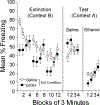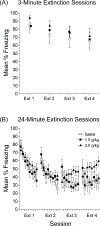Effects of ethanol on encoding, consolidation, and expression of extinction following contextual fear conditioning
- PMID: 18085881
- PMCID: PMC7247427
- DOI: 10.1037/0735-7044.121.6.1280
Effects of ethanol on encoding, consolidation, and expression of extinction following contextual fear conditioning
Abstract
Studies of contextual fear conditioning have found that ethanol administered prior to a conditioning session impairs the conditioned freezing response during a test session the next day. The present experiments examined the effects of ethanol on extinction, the loss of conditioned responding that occurs as the animal learns that a previously conditioned context no longer signals shock. Ethanol (1.5 g/kg) administered prior to single (Experiment 1) or multiple (Experiment 2) extinction sessions impaired extinction. Ethanol administered prior to a test session disrupted the expression of freezing after extinction (Experiments 3-5). There was some evidence that ethanol served as an internal stimulus signaling the operation of conditioning or extinction contingencies (Experiments 4-5). In Experiment 6, postsession injections of 1.5 g/kg ethanol had no effect on extinction with brief (3 min) or long (24 min) exposures to the context, but injections of 3 g/kg after long exposures impaired extinction. Together, these results indicate that ethanol affects extinction by acting on multiple learning and performance processes, including attention, memory encoding, and memory expression.
Figures






Similar articles
-
Inhaled Lavandula angustifolia essential oil enhances extinction learning and inhibits memory updating in mice submitted to the contextual fear conditioning.J Ethnopharmacol. 2020 Oct 5;260:113048. doi: 10.1016/j.jep.2020.113048. Epub 2020 Jun 7. J Ethnopharmacol. 2020. PMID: 32525067
-
Hippocampal encoding of interoceptive context during fear conditioning.Transl Psychiatry. 2017 Jan 3;7(1):e991. doi: 10.1038/tp.2016.254. Transl Psychiatry. 2017. PMID: 28045462 Free PMC article.
-
Consequences of ethanol exposure on cued and contextual fear conditioning and extinction differ depending on timing of exposure during adolescence or adulthood.Behav Brain Res. 2013 Nov 1;256:10-9. doi: 10.1016/j.bbr.2013.08.013. Epub 2013 Aug 9. Behav Brain Res. 2013. PMID: 23938333 Free PMC article.
-
Acute nicotine delays extinction of contextual fear in mice.Behav Brain Res. 2014 Apr 15;263:133-7. doi: 10.1016/j.bbr.2014.01.031. Epub 2014 Jan 31. Behav Brain Res. 2014. PMID: 24487010 Free PMC article.
-
Effect of chronic alcohol exposure and single-prolonged stress on conditioned fear behavior.Behav Brain Res. 2025 Feb 4;477:115294. doi: 10.1016/j.bbr.2024.115294. Epub 2024 Oct 16. Behav Brain Res. 2025. PMID: 39419182
Cited by
-
Characteristics of retrograde amnesia for CS preexposure.Learn Behav. 2017 Sep;45(3):243-251. doi: 10.3758/s13420-017-0259-0. Learn Behav. 2017. PMID: 28181182
-
Punishment of alcohol-reinforced responding in alcohol preferring P rats reveals a bimodal population: Implications for models of compulsive drug seeking.Prog Neuropsychopharmacol Biol Psychiatry. 2018 Dec 20;87(Pt A):68-77. doi: 10.1016/j.pnpbp.2017.07.020. Epub 2017 Jul 25. Prog Neuropsychopharmacol Biol Psychiatry. 2018. PMID: 28754407 Free PMC article.
-
Mechanisms of alcohol influence on fear conditioning: a computational model.bioRxiv [Preprint]. 2024 Jan 1:2023.12.30.573310. doi: 10.1101/2023.12.30.573310. bioRxiv. 2024. Update in: Alcohol Clin Exp Res (Hoboken). 2025 Jun;49(6):1233-1247. doi: 10.1111/acer.70071. PMID: 38260700 Free PMC article. Updated. Preprint.
-
Rapid reacquisition of contextual fear following extinction in mice: effects of amount of extinction, acute ethanol withdrawal, and ethanol intoxication.Psychopharmacology (Berl). 2019 Jan;236(1):491-506. doi: 10.1007/s00213-018-5057-7. Epub 2018 Oct 18. Psychopharmacology (Berl). 2019. PMID: 30338488 Free PMC article.
-
What does it take to demonstrate memory erasure? Theoretical comment on Norrholm et al. (2008).Behav Neurosci. 2008 Oct;122(5):1186-90. doi: 10.1037/a0012993. Behav Neurosci. 2008. PMID: 18823175 Free PMC article. Review.
References
-
- Akirav I, Raizel H and Maroun M (2006). Enhancement of conditioned fear extinction by infusion of the GABA agonist muscimol into the rat prefrontal cortex and amygdala. Eur J Neurosci 23, 758–64. - PubMed
-
- Bevins RA, Rauhut AS, McPhee JE and Ayres JJB (2000). One-trial context fear conditioning with immediate shock: The roles of transport and contextual cues. Journal of Experimental Psychology: Animal Behavior Processes 28, 162–171. - PubMed
-
- Bouton ME (1991). Context and retrieval in extinction and in other examples of interference in simple associative learning Current topics in animal learning: Brain, emotion, and cognition. Dachowski L and Flaherty CF. Hillsdale, NJ, USA, Lawrence Erlbaum Associates, Inc: 25–53.
-
- Bouton ME and Bolles RC (1979). Contextual control of the extinction of conditioned fear. Learning & Motivation 10, 445–466.
-
- Bouton ME and Garcia-Gutierrez A (2006). Intertrial interval as a contextual stimulus. Behav Processes 71, 307–17. - PubMed

